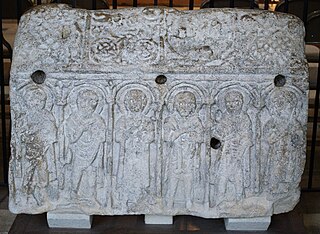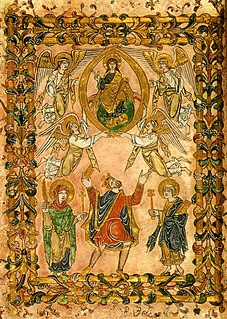Related Research Articles

Augustine of Canterbury was a Benedictine monk who became the first Archbishop of Canterbury in the year 597. He is considered the "Apostle to the English" and a founder of the English Church.

Æthelstan or Athelstan was King of the Anglo-Saxons from 924 to 927 and King of the English from 927 to 939 when he died. He was the son of King Edward the Elder and his first wife, Ecgwynn. Modern historians regard him as the first King of England and one of the greatest Anglo-Saxon kings. He never married and had no children. He was succeeded by his half-brother, Edmund.

Gildas — also known as Gildas the Wise or Gildas Sapiens — was a 6th-century British monk best known for his scathing religious polemic De Excidio et Conquestu Britanniae, which recounts the history of the Britons before and during the coming of the Saxons. He is one of the best-documented figures of the Christian church in the British Isles during the sub-Roman period, and was renowned for his Biblical knowledge and literary style. In his later life, he emigrated to Brittany where he founded a monastery known as St Gildas de Rhuys.
Wilfrid was an English bishop and saint. Born a Northumbrian noble, he entered religious life as a teenager and studied at Lindisfarne, at Canterbury, in Gaul, and at Rome; he returned to Northumbria in about 660, and became the abbot of a newly founded monastery at Ripon. In 664 Wilfrid acted as spokesman for the Roman position at the Synod of Whitby, and became famous for his speech advocating that the Roman method for calculating the date of Easter should be adopted. His success prompted the king's son, Alhfrith, to appoint him Bishop of Northumbria. Wilfrid chose to be consecrated in Gaul because of the lack of what he considered to be validly consecrated bishops in England at that time. During Wilfrid's absence Alhfrith seems to have led an unsuccessful revolt against his father, Oswiu, leaving a question mark over Wilfrid's appointment as bishop. Before Wilfrid's return Oswiu had appointed Ceadda in his place, resulting in Wilfrid's retirement to Ripon for a few years following his arrival back in Northumbria.

Edmund the Martyr was king of East Anglia from about 855 until his death.
Oda, called the Good or the Severe, was a 10th-century Archbishop of Canterbury in England. The son of a Danish invader, Oda became Bishop of Ramsbury before 928. A number of stories were told about his actions both prior to becoming and while a bishop, but few of these incidents are recorded in contemporary accounts. After being named to Canterbury in 941, Oda was instrumental in crafting royal legislation as well as involved in providing rules for his clergy. Oda was also involved in the efforts to reform religious life in England. He died in 958 and legendary tales afterwards were ascribed to him. Later he came to be regarded as a saint, and a hagiography was written in the late 11th or early 12th century.

Anna was king of East Anglia from the early 640s until his death.

Eadfrith of Lindisfarne, also known as Saint Eadfrith, was Bishop of Lindisfarne, probably from 698 onwards. By the twelfth century it was believed that Eadfrith succeeded Eadberht and nothing in the surviving records contradicts this belief. Lindisfarne was among the main religious sites of the kingdom of Northumbria in the early eighth century, the resting place of Saints Aidan and Cuthbert. He is venerated as a Saint in the Roman Catholic Church, and in the Eastern Orthodox Church, as also in the Anglican Communion.

Saint Edith of Wilton was an English nun, a daughter of Edgar the Peaceful, king of England. She was born between 961 and 964 and died on 16 September in a year between 984 and 987. Following her death in 984, she became the patron saint of her community at Wilton Abbey in Wiltshire and churches were dedicated to her in Wiltshire and in other parts of Anglo-Saxon England. Her biography was written by Goscelin and her feast day is on 16 September.

Plegmund was a medieval English Archbishop of Canterbury. He may have been a hermit before he became archbishop in 890. As archbishop, he reorganised the Diocese of Winchester, creating four new sees, and worked with other scholars in translating religious works. He was canonised after his death.

Medeshamstede was the name of Peterborough in the Anglo-Saxon period. It was the site of a monastery founded around the middle of the 7th century, which was an important feature in the kingdom of Mercia from the outset. Little is known of its founder and first abbot, Sexwulf, though he was himself an important figure, and later became bishop of Mercia. Medeshamstede soon acquired a string of daughter churches, and was a centre for an Anglo-Saxon sculptural style.
Saint Edith of Polesworth is an obscure Anglo-Saxon abbess associated with Polesworth (Warwickshire) and Tamworth (Staffordshire) in Mercia. Her historical identity and floruit are uncertain. Some late sources make her a daughter of King Edward the Elder, while other sources claim she is the daughter of Egbert of Wessex. Her feast day is 15 July.
Ælfflæd was the second wife of the English king Edward the Elder.
Saint Ælfgifu of Shaftesbury, also known as Saint Elgiva was the first wife of Edmund I, by whom she bore two future kings, Eadwig and Edgar. Like her mother Wynflaed, she had a close and special if unknown connection with the royal nunnery of Shaftesbury (Dorset), founded by King Alfred, where she was buried and soon revered as a saint. According to a pre-Conquest tradition from Winchester, her feast day is 18 May.

Hemming's Cartulary is a manuscript cartulary, or collection of charters and other land records, collected by a monk named Hemming around the time of the Norman Conquest of England. The manuscript comprises two separate cartularies that were made at different times and later bound together; it is in the British Library as MS Cotton Tiberius A xiii. The first was composed at the end of the 10th or beginning of the 11th century. The second section was compiled by Hemming and was written around the end of the 11th or the beginning of the 12th century. The first section, traditionally titled the Liber Wigorniensis, is a collection of Anglo-Saxon charters and other land records, most of which are organized geographically. The second section, Hemming's Cartulary proper, combines charters and other land records with a narrative of deprivation of property owned by the church of Worcester.
Botwine was a Northumbrian saint venerated at Ripon and Peterborough. He is well documented as a priest, and latter Abbot of Ripon. The Anglo-Saxon Chronicle recension E, recorded his death in the 780s in one of three Ripon abbatial obits derived from a chronicle of Northumbrian origin. Following the death of St Botwine in 786AD, his replacement, Ealdberht was elected and consecrated Abbot. Ealdberht died in 788AD, and was himself succeeded as Abbot by St. Sigered of Ripon.
Indract or Indracht was an Irish saint who, along with his companions, was venerated at Glastonbury Abbey, a monastery in the county of Somerset in south-western England. In the High Middle Ages Glastonbury tradition held that he had been an Irish pilgrim — a king's son – on his way back from Rome who was molested and killed by a local thegn after he had stopped off to visit the shrine of St Patrick. This tradition synchronised his life with that of King Ine (688–726), though historian Michael Lapidge has argued that he is most likely to represent a 9th-century abbot of Iona named Indrechtach ua Fínnachta.
Wilfrida also known as Wulfthryth, was a Catholic female saint and abbess from Anglo-Saxon England who was venerated locally in Wiltshire.

The English Benedictine Reform or Monastic Reform of the English church in the late tenth century was a religious and intellectual movement in the later Anglo-Saxon period. In the mid-tenth century almost all monasteries were staffed by secular clergy, who were often married. The reformers sought to replace them with celibate contemplative monks following the Rule of Saint Benedict. The movement was inspired by Continental monastic reforms, and the leading figures were Dunstan, Archbishop of Canterbury, Æthelwold, Bishop of Winchester, and Oswald, Archbishop of York.
A cult of saints played a key part within Anglo-Saxon Christianity, a form of Roman Catholicism practiced in Anglo-Saxon England from the late sixth to the mid eleventh century.
References
- Blair, John (2002), "A Handlist of Anglo-Saxon Saints", in Thacker, Alan; Sharpe, Richard (eds.), Local Saints and Local Churches in the Early Medieval West, Oxford: Oxford University Press, pp. 495–565, ISBN 0-19-820394-2
- Dumville, D. N. (1992), Liturgy and the Ecclesiastical History of late Anglo-Saxon England: Four Studies, Woodbridge: Boydell Press, ISBN 0-85115-331-3
- de G. Birch, W. (1896), "Ivy-Church", Wiltshire Notes and Queries: An Illustrated Quarterly Antiquarian and Genealogical Magazine, Volume I, Devizes G. Simpson, p. 83